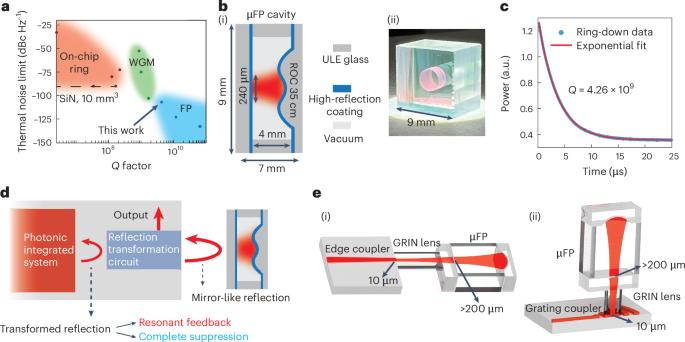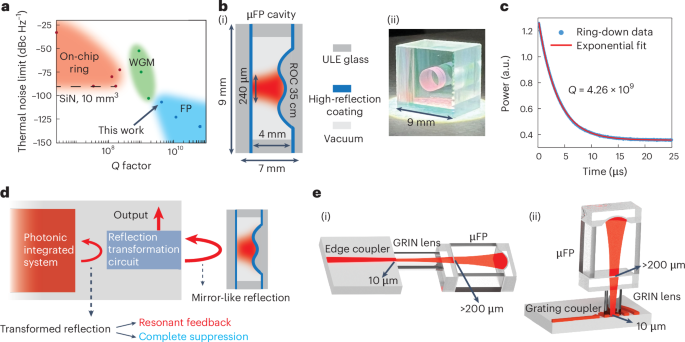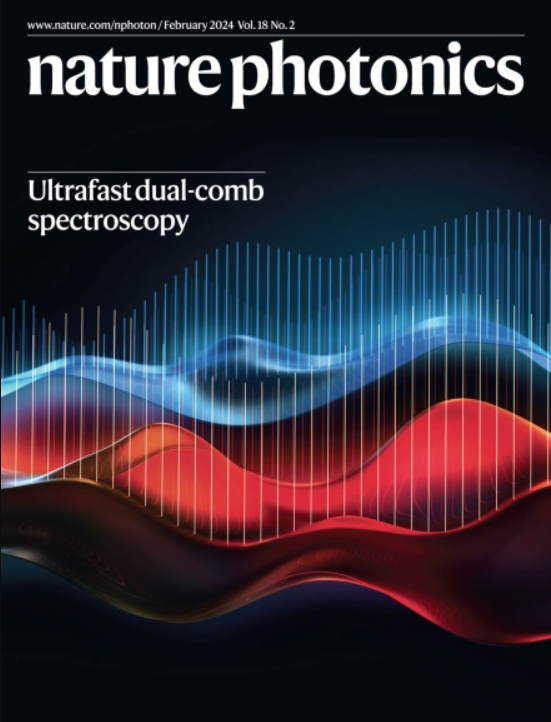Harnessing micro-Fabry–Pérot reference cavities in photonic integrated circuits
IF 32.9
1区 物理与天体物理
Q1 OPTICS
引用次数: 0
Abstract
Compact photonic systems that offer high frequency stability and low noise are of increasing importance to applications in precision metrology, quantum computing, communication and advanced sensing technologies. However, on-chip resonators comprising dielectrics cannot match the frequency stability and noise characteristics of Fabry–Pérot cavities, whose electromagnetic modes live almost entirely in vacuum. Here we present a novel strategy to interface microfabricated Fabry–Pérot cavities with photonic integrated circuits to realize compact, high-performance integrated systems. Using this new integration approach, we demonstrate the self-injection locking of an on-chip laser to a millimetre-scale vacuum-gap Fabry–Pérot cavity using a circuit interface that transforms the reflected cavity response to enable efficient feedback to the laser. This system achieves a phase noise of –97 dBc Hz–1 at 10-kHz offset frequency, a fractional frequency stability of 5 × 10−13 at 10 ms, a 150-Hz 1/π integral linewidth and a 35-mHz fundamental linewidth. We also present a complementary integration strategy that utilizes a vertical-emission grating coupler and a back-reflection cancellation circuit to realize a fully co-integrated module that effectively redirects the reflected signals and isolates back-reflections with a 10-dB suppression ratio, serving as a key for on-chip Pound–Drever–Hall locking. Together, these results highlight how vacuum-gap Fabry–Pérot reference cavities can be harnessed for ultrastable, low-noise photonic systems. Self-injection locking of an on-chip laser to a milimetre-scale vacuum-gap Fabry–Pérot cavity is demonstrated, with a phase noise of –97 dBc Hz–1 at a 10-kHz offset frequency and a fractional frequency stability of 5 × 10−13 at 10 ms, enabling next-generation high-performance integrated systems.


在光子集成电路中利用微型法布里-普氏参考腔
具有高频率稳定性和低噪声的紧凑光子系统在精密计量、量子计算、通信和先进传感技术中的应用越来越重要。然而,包含电介质的片上谐振器无法与法布里-帕姆罗腔的频率稳定性和噪声特性相匹配,法布里-帕姆罗腔的电磁模式几乎完全生活在真空中。本文提出了一种将微加工法布里-帕姆罗腔与光子集成电路相结合的新方法,以实现紧凑、高性能的集成系统。使用这种新的集成方法,我们演示了片上激光器的自注入锁定到毫米级真空间隙法布里-帕姆罗特腔中,使用电路接口转换反射腔响应以实现对激光器的有效反馈。该系统在10- khz偏置频率下的相位噪声为-97 dBc Hz-1,在10 ms下的分数频率稳定性为5 × 10−13,150 hz的1/π积分线宽和35 mhz的基本线宽。我们还提出了一种互补集成策略,利用垂直发射光栅耦合器和反向反射抵消电路来实现完全协集成模块,该模块有效地重定向反射信号并以10 db的抑制比隔离反向反射,作为片上Pound-Drever-Hall锁定的关键。总之,这些结果突出了如何利用真空间隙法布里-帕姆罗参考腔来实现超稳定、低噪声的光子系统。
本文章由计算机程序翻译,如有差异,请以英文原文为准。
求助全文
约1分钟内获得全文
求助全文
来源期刊

Nature Photonics
物理-光学
CiteScore
54.20
自引率
1.70%
发文量
158
审稿时长
12 months
期刊介绍:
Nature Photonics is a monthly journal dedicated to the scientific study and application of light, known as Photonics. It publishes top-quality, peer-reviewed research across all areas of light generation, manipulation, and detection.
The journal encompasses research into the fundamental properties of light and its interactions with matter, as well as the latest developments in optoelectronic devices and emerging photonics applications. Topics covered include lasers, LEDs, imaging, detectors, optoelectronic devices, quantum optics, biophotonics, optical data storage, spectroscopy, fiber optics, solar energy, displays, terahertz technology, nonlinear optics, plasmonics, nanophotonics, and X-rays.
In addition to research papers and review articles summarizing scientific findings in optoelectronics, Nature Photonics also features News and Views pieces and research highlights. It uniquely includes articles on the business aspects of the industry, such as technology commercialization and market analysis, offering a comprehensive perspective on the field.
 求助内容:
求助内容: 应助结果提醒方式:
应助结果提醒方式:


